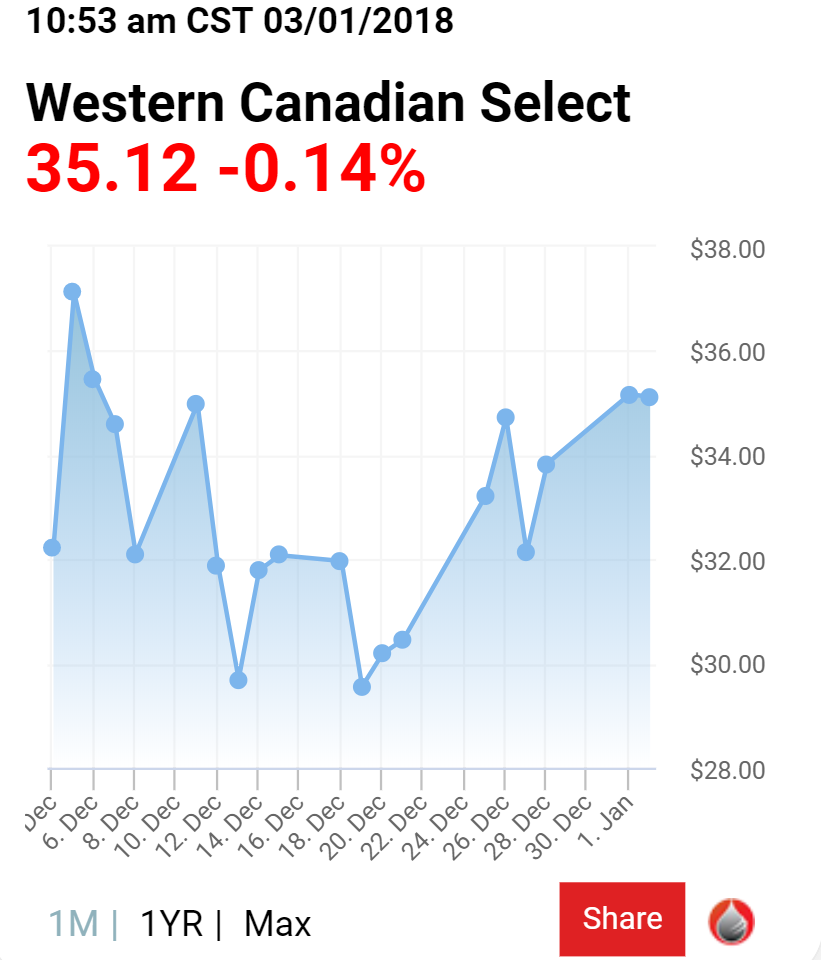Oil Price Could Rise to $100, Due to the
Deepening Iranian Crisis and Falling Canadian Rig Count
By Nick
Cunningham
Oilprice.com, Al-Jazeerah, CCUN,
January 4, 2018
|
 |
 |
 |
|
|
Iranian students protesting at the University of Tehran,
December 30, 2017 |
Iranian Crisis Could Send Oil to $100
Oil prices started the year on a high note as some geopolitical
tension pushed aside bearish concerns. Both WTI and Brent opened above
$60 per barrel for the first time in years.
The protests in Iran were the main driver of the bullish sentiment in
the oil market. Anti-government demonstrations swept across the country
in recent days, and unlike the widespread protests in 2009, the current
rallies are related to economic woes and are also taking place in more
cities than just Tehran. “Growing unrest in Iran set the table for a
bullish start to 2018,” the Schork Report
said in a note to clients on January 2.
At least
14 people have been killed in the protests and an estimated 450 have
been arrested. It is the most serious challenge to the Iranian
government in years, and Iran’s Supreme Leader put the blame on foreign
agents, presumably the United States. “In recent days, enemies of Iran
used different tools including cash, weapons, politics and intelligence
apparatus to create troubles for the Islamic Republic,” Ayatollah Ali
Khamenei said.
Meanwhile, tension over North Korea – although not a new development
– could be spreading to include a spat between the U.S. and Russia as
well as the U.S. and China. Reuters
reported late last week that Russian oil tankers have sent fuel to
North Korea on multiple occasions in the last few months by transferring
cargoes at sea. If true, the actions would amount to a violation of UN
sanctions. Sources told Reuters that there is no evidence that the
Russian state was involved, but the news has raised the specter of
U.S.-Russian tension as Washington seeks a hard line on Pyongyang.
Related: Oil Sees Strongest Start Of Year Since 2014
The spat over oil shipments to North Korea is also centered on China.
South Korea
seized two ships that were allegedly carrying oil to North Korea.
The U.S. has been trying to get the UN Security Council to blacklist a
number of ships suspected of sending oil to North Korea, but China has
resisted such efforts. The incident has raised suspicion in Washington
that China is circumventing UN sanctions and providing a lifeline to
North Korea.
The two geopolitical flashpoints seemed to outweigh bearish concerns
over the
return of the 450,000-bpd Forties pipeline to operation. The key
North Sea conduit came online in recent days, restoring disrupted North
Sea oil to the market. Libya also
repaired an oil pipeline that funnels crude to its Es Sider export
terminal, easing concerns about disrupted supply. The expected return of
supply from both countries has been cited by analysts as reasons to
expect a selloff in crude prices at the start of the year, but so far,
the tensions in Iran and North Korea have carried the day.
With that said, the odds of a tangible disruption from these
geopolitical events is minimal. “I don’t think we’re seeing much
immediate risk from these [Iran] protests which are taking place in
urban areas but I think it’s the backdrop—both political and in the oil
market—that mean these are catching attention,” said Richard Mallinson,
analyst at consultancy Energy Aspects, according to
the WSJ. “Geopolitics is going to be much more in focus now that
we’re in a tighter market.”
Related: U.S. Shale Can’t Offset Record-Low Oil Discoveries
But Iran’s oil fields are located far away from any serious impact
from the demonstrations. “As of yet there is no deep seated concern for
a disruption of Iran’s 3.8 mb/d crude oil production,” Bjarne Schieldrop,
chief commodities analyst at SEB, said in a statement. “However, if it
was to happen it would have a huge impact on the global crude oil
prices. A full disruption of such a magnitude would immediately drive
the Brent crude oil price above the $100/bl mark.”
As concerns of a supply disruption from Iran start to wane, as seems
likely, the focus will shift back to the fundamentals. The IEA, among
others, predict a return to inventory builds in the first and possibly
second quarter of this year. Also, investors have racked up an extremely
lopsided bet on crude futures, and such levels of bullishness tend to
precede a selloff. That means that as these geopolitical events lose
salience, the short run risk for oil prices is very much on the
downside.
“Not having at least one solid correction to the downside in 2018
with such a mega bullish allocation to start with would probably be the
biggest surprise of all this year,” Schieldrop added.
***
What’s Behind The Canadian Rig Count Crash
By
Nick Cunningham - Jan 03, 2018, 6:01 PM CST
The U.S. rig count has been on the rise for months, despite some
recent hiccups, but Canada’s rig count recently plunged amid low oil
prices.
Canada’s rig count fell from 210 to 136 for the week ending on
December 29, a massive drop off. That took the rig count to a
six-month low. Obviously, the losses were concentrated in Alberta,
where most of the rigs tend to be. Alberta’s rig count sank from 162
to 118 in the last week of 2017. But Saskatchewan also saw its rig
count decimated—falling from 43 in mid-December to just three at the
close of the year.

The losses can likely be chalked up to the meltdown in prices for
Canadian oil.
Western Canada Select (WCS), a benchmark that tracks heavy oil
in Canada, often trades at a significant discount to oil prices in
the United States. But the WCS-WTI discount became unusually large
in November and December for a variety of reasons. The outage at the
Keystone pipeline led to a rapid buildup in oil inventories in
Canada, and
storage hit a record high in December.
Also, Canada’s oil industry has been unable to build new pipelines
to get the landlocked oil from Alberta to market. Alberta oil
producers are essentially hostage to their buyers in the U.S., and
with oil production now bumping up against a ceiling in terms of
pipeline capacity, the glut is starting to weigh on WCS prices.
In December, Enbridge
announced that it will ration the space on its Mainline oil
pipeline system for January as Canada’s pipelines are essentially at
full capacity. Enbridge said that it will apportion lines 4 and 67,
which move heavy crude, by 36 percent. The term “apportionment” is a
euphemism for rationing—essentially oil producers are unable to get
all of their product onto the pipeline and are hit with
restrictions. That means the oil has to be diverted into storage.
In short, there’s somewhat of a glut of supply in Canada right now.
The problem is that there’s little prospect of a solution in the
near-term. Railroads, although they are taking incrementally more
cargoes, cannot handle the excess supply all on their own,
especially with new supply coming online. And there are no serious
pipeline capacity additions expected for about two years at the
earliest. The three main proposals—Kinder Morgan’s Trans Mountain
Expansion; TransCanada’s Keystone XL; and Enbridge’s Line 3
replacement—all face legal questions and uncertain completion dates.
On top of that, Canada’s oil sands producers are adding new supply.
At today’s prices, it makes little sense to greenlight new upstream
projects, particularly in expensive oil sands. But there are still
some projects that are finishing up that were given the go-ahead
years ago when oil prices were substantially higher. Suncor Energy
is set to bring its Fort Hills project online, which will add nearly
200,000 bpd of new supply within 12 months.
That all means that the pressure on WCS probably won’t go away. The
price meltdown from two months ago is probably now showing up in the
rig count. The U.S. typically sees the rig count fluctuate in
response to changes in the oil price by several months, and the rig
count in Canada will only now start to reflect the price plunge from
months ago. The rail industry might handle more oil cargoes, which
could help push up WCS a bit, but the larger-than-usual discount
might persist for some time.
Canada could add new refining capacity to process all of that oil
right at home, an option that is often raised when WCS prices tank.
IHS Markit recently
studied several scenarios for Canada’s oil industry, including
upgrading existing refineries to process heavy oil into a lighter
synthetic form of oil, as well as building entirely new refineries.
IHS Markit concluded that there is an opportunity to convert
existing refineries, but that the abundance of light oil supply in
North America could challenge the economics. New refining capacity
is a risk. In any event, refined products and lighter oil would
still need to be exported via pipeline.
In short, Canada’s oil industry faces more obstacles than, say, the
much-watched shale drillers in the United States. The U.S. rig count
is closely tracked around the world for clues into what happens next
in the oil market—an increase is assumed to mean that more U.S.
shale supply will be forthcoming while a decrease is a sign of
market tightness and potentially higher prices. The publication of
this weekly data has global implications.
Canada’s rig count, on the other hand, could continue to struggle
even as U.S. shale drillers spring into action in response to higher
prices. Canadian producers won’t benefit as much from the upswing in
the global market due to their local and regional problems, mostly
related to the lack of pipeline capacity.

https://oilprice.com/Energy/Crude-Oil/Whats-Behind-The-Canadian-Rig-Count-Crash.html
**
Share the link of this article with your facebook friends







